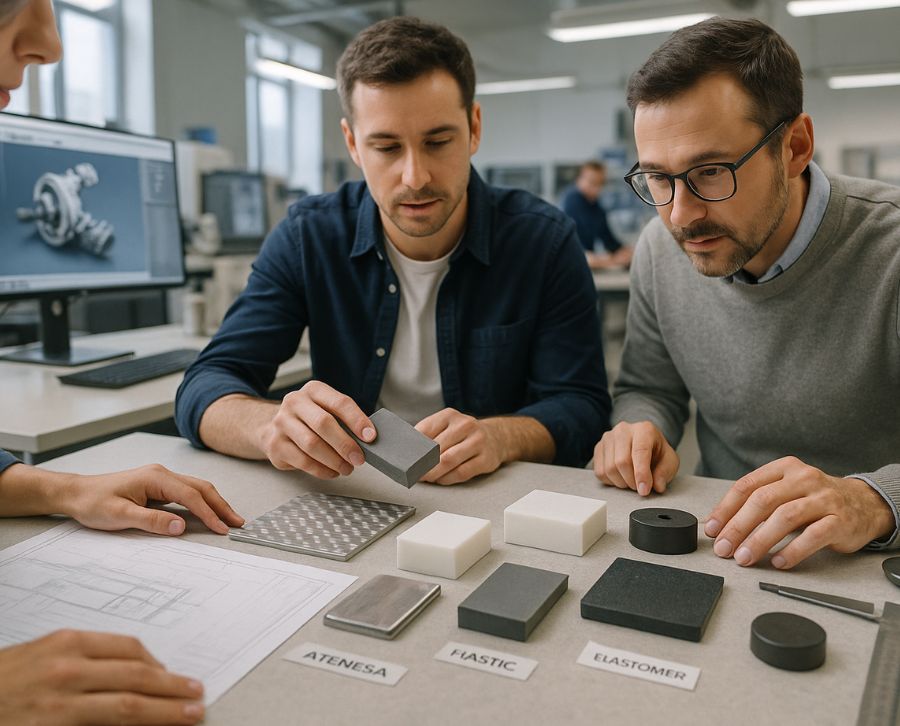Selecting construction materials is the most important step when starting a project. There are many elements to consider, such as quality and functionality. Furthermore, the cost of the materials will depend on the factors mentioned above.
At Atienza y Climent, we offer comprehensive design, prototyping, and manufacturing services, providing specialized advice. Our experience guarantees efficient and customized solutions for each case, covering many scenarios.
To clarify any questions you may have, we have prepared this guide to answer your questions. By doing so, we will facilitate decision-making to achieve all business objectives.

Introduction to materials selection
The material selection process is extremely strict. Various requirements and regulations must be met to ensure the success of your ventures. If you choose wisely, you can enjoy optimal performance when carrying out your activities.
By understanding the properties of materials, professionals such as engineers and designers will have the option to choose the most appropriate options. This is very important because it avoids problems and optimizes industrial resources.
Likewise, there are cases worthy of study, such as the eternal dispute between thermoplastics vs. thermosets. Both terms are similar; however, due to their unique qualities, it is not easy to determine which is best.
However, we believe that if you want strength, select thermosets. Otherwise, thermoplastics are ideal for tasks that require flexibility. It all depends on your situation, so you may need both.
Why is it crucial to choose the right material?
Choosing the right material ensures that the product performs its functions without premature failure, avoiding extra costs for repairs or maintenance. For this reason, it is necessary to understand the most striking characteristics of these components to anticipate mechanical variables.
It is also important to consider the environmental impact when incorporating recyclable materials and biopolymers. This is very important, as it reduces the ecological footprint without sacrificing quality or performance.
Key factors to consider (mechanical, thermal, cost, sustainability)
Mechanical properties, such as strength, hardness, and flexibility, are necessary to withstand loads and stresses. Therefore, we recommend conducting an intelligent assessment to ensure your product meets these requirements.
The thermal factor is equally important. Variables such as stability and conductivity are vital in environments with temperature variations. Iron factories are one of the industries that use these products.
Did you know that cost and availability affect the viability of the business? The selection of materials must be professional and transparent to avoid overpaying for the use of these components.
Finally, sustainability is essential. Right now, the progressive demand is so great that companies have been forced to implement these mechanisms. Do you want to join the sustainable revolution? Then choose Atienza & Climent.
Knowing the types of polymers
Material selection criteria should focus on recognizing the different types of polymers.
- Thermoplastics
- Thermosets
- Elastomers
- Each alternative has its own characteristics. These specifications determine their suitability based on the location where they will be implemented.
Thermoplastics and their properties
This classification is distinguished by its temperature adaptation. Basically, they soften at high temperatures and solidify upon cooling. Best of all, they do not lose their properties, making them easy to mold using techniques such as injection molding and extrusion.
They are versatile and economical, ideal for packaging, industrial parts, and prototypes. They are notable for their ease of processing and recyclability, elements that are highly valued in modern industry. Polyethylene, polypropylene, and polyvinyl chloride are some examples.
Thermosets and their advantages
The cross-linked chemical structure of these products makes them rigid and resistant to high temperatures. Once cured, they cannot be remelted, ensuring dimensional stability and mechanical strength.
Their use in the aerospace, automotive, and electronics industries is among the most attractive to consumers. Epoxy and phenolic resins are durable, allowing them to be used in a variety of applications. Furthermore, their recycling is more complex, so they must be carefully evaluated in projects with a sustainable focus.
Elastomers and their elasticity
By deforming and returning to its original shape, this type of polymer works very well in applications involving seals, gaskets, and anti-vibration components. Natural rubber, polyurethane, and silicone offer resistance to the wear and tear found in many industries.
Its use in prototypes is key to validating designs that require flexibility and durability. This is by far the greatest advantage it offers users. We consider it to be the most versatile option on the market and the one with the most advantages.
Materials selection methodology
By making the right choice, you’ll be able to identify the project’s specific needs. The number of aspects to consider can be overwhelming, but mechanical loads, temperatures, environmental exposure, and regulations are the ones you should analyze.
Likewise, it’s mandatory to analyze variables such as environmental impact and recyclability. Decision diagrams are ideal for making a good comparison, allowing you to rule out options with low ratings.
Identifying project requirements
This is a very comprehensive prototype materials guide, as it includes a professional identification system. Yes, we understand that different companies have different needs; therefore, it’s a good idea to create a results filtering system.
Don’t forget that production line managers are responsible for avoiding defective materials. Highly efficient part sourcing is a priority, so the final product must be composed of unique and powerful parts.
Evaluating options: cost and availability of each material
Achieving the perfect balance between cost and production time is difficult. The material with the best properties isn’t always viable if its price is too high or its supply is limited. You have to evaluate the economic viability and availability of each option.
Sustainability and recyclability considerations
As we mentioned, international policies are becoming increasingly strict. This is one of the reasons why industries are opting to replace traditional materials with sustainable ones.
Biopolymers are derived from natural sources. This quality allows them to perform very well in any type of environment. After analyzing the available scenarios, we determined that restaurants make excellent use of these resources.
Step-by-step decision diagram
The development of these planning systems offers a number of positive aspects. In short, it makes the decision easier to make.
To begin, start by drawing a square that represents the decision to be evaluated and made.
The next step is to place lines emerging from the square and ending in another shape. Imagine them as the branches of a tree. These branches represent the paths that can be chosen to reach the final result.
Place the percentage of probability on each line.
Add the expected values to each shape. In the probability sections, a base average is calculated, and in the choice areas, the most useful is chosen.
Finally, place the options with the greatest relevance and positive aspects based on the nature of the work.
It’s important to note that there are many graphic styles, so a specific one may apply to your action plan.
Conclusions and recommendations
The correct selection of materials is key to ensuring functionality, efficiency, and sustainability in any project. Applying a methodology based on technical and environmental requirements improves results.
To avoid making mistakes when choosing a resource that will appeal to your project, you must receive appropriate advice. Likewise, the specialist must have a proven track record.
Methodology summary
Elastomers have varied characteristics and uses. This is one of the reasons why they are the most widely used resource by large industries. There are other alternatives, so you should study your company’s purpose to determine the best one.
Additional resources and expert consultations
Consulting with companies like Atienza and Climent is essential for the correct selection of materials. Our experience in design, prototyping, and manufacturing guarantees personalized assistance throughout the entire process.
Frequently asked questions about industrial materials
Selecting the right material ensures the functionality, durability, and efficiency of the final product. An incorrect choice can lead to premature failure, additional maintenance costs, and performance issues in demanding industrial environments.
The main factors are mechanical properties (strength, hardness, flexibility), thermal behavior, cost and availability, and environmental sustainability. A good selection seeks a balance between technical performance and economic viability.
Thermoplastics soften with heat and can be molded repeatedly, making them recyclable and versatile.
Thermosets, on the other hand, are rigid, resistant to high temperatures, and do not melt after curing, making them ideal for demanding applications such as automotive or electronics.
Elastomers are highly elastic materials that recover their original shape after deformation. They are used in seals, gaskets, shock absorbers, and flexible prototypes, where resistance to wear and vibration is required.
More and more industries are prioritizing recyclable materials or biopolymers derived from natural sources. This reduces the environmental footprint without sacrificing quality, aligning projects with international sustainability standards.
The ideal methodology includes:
Identifying project requirements.
Evaluating physical and chemical properties.
Comparing cost and availability.
Analyzing environmental impact and recyclability.
Using decision diagrams to choose the most balanced option.



